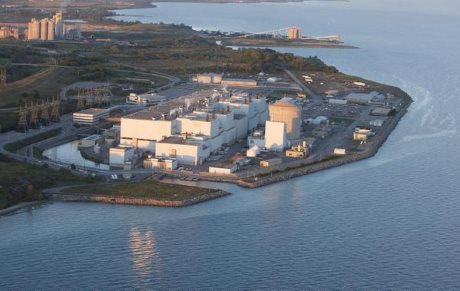A Canadian Nuclear Safety Commission (CNSC) study has concluded that there would be no detectable increase in cancer risk for most of the population from radiation released in a hypothetical severe nuclear accident.
 |
| The study modelled a hypothetical severe accident at OPG's Darlington plant (Image: OPG) |
The CNSC's Study of Consequences of a Hypothetical Severe Nuclear Accident and Effectiveness of Mitigation Measures is the result of a collaborative effort of research and analysis undertaken to address concerns raised during public hearings on the environmental assessment for the refurbishment of Ontario Power Generation's (OPG's) Darlington nuclear power plant in 2012. The draft study was released for public consultation in June 2014. Feedback from the Commission itself and comments from over 500 submissions from the public, government and other organizations have been incorporated in the final version.
The study involved identifying and modelling a large atmospheric release of radionuclides from a hypothetical severe nuclear accident at the four-unit Darlington plant; estimating the doses to individuals at various distances from the plant, after factoring in protective actions such as evacuation that would be undertaken in response to such an emergency; and, finally, determining human health and environmental consequences due to the resulting radiation exposure.
The study started by establishing a "source term" to define the radionuclides released and their relative quantities, reflecting the reactors at Darlington. In an accident situation the plant's containment would be expected to delay the release of radionuclides, so the study assumed a delay between accident and release of 24 hours. Scenarios were assessed for releases lasting one, 24 and 72 hours, and a four-fold increase in the release to model an accident affecting all four Darlington reactors was also considered.
The study applied standards from Ontario's emergency response plans to model the protective actions such as evacuation, sheltering indoors, and administration of potassium iodide pills that would be taken in the emergency situation. The residual doses remaining after protective actions were then used as inputs in a human health risk assessment.
The study found that while some evacuations would be needed close to the plant, given the estimated doses evacuation beyond a 12 km zone from the plant would not be required even under the worst-case scenario. With respect to human health, the report found that it would be nearly impossible to distinguish radiation-induced cancers from those that would be expected to occur in the population: the increased risk of developing all cancers, leukaemia and adult thyroid cancer from exposure to a hypothetical accident scenario would result in an additional 0.0004 % chance of developing cancer on top of the 49% baseline risk of developing such cancers in Ontario.
The only radiation-induced cancer that could be distinguished from baseline cancers was childhood thyroid cancer, with an increased risk predicted for all scenarios. In the worst-case scenario, representative of an accident in multiple nuclear units, the predicted excess future risk of developing childhood thyroid cancer in close proximity to the plant was an additional 0.3 % above a baseline future risk of approximately 1 %. Children's thyroid glands are more sensitive to radiation than those of adults, and the report's findings emphasize the importance of considering "sensitive receptors" such as children in emergency response planning.
The risk to human health is likely to have been overestimated, the study notes, as it is based on modelled radionuclide transport, dispersion and dose estimates rather than actual measurements. "The overestimation resulting from preliminary modelling has been demonstrated following the Fukushima accident where doses estimated based on post release measurements were shown to be two to five times less than the preliminary estimated modelled doses. For additional perspective, the measured doses at Fukushima are comparable to the estimated doses in this study, and international authorities have indicated an increased incidence in cancer (e.g. thyroid cancer) is unlikely to be observed in the future in Japan", it says.
The CNSC added that the modelled accident assumed a radioactive release without allowing for the plant-specific design features and operator actions, including lessons learned from Fukushima, that would in practice mitigate such a situation. "Had all of the plant-specific safety design features, operator actions and other Fukushima enhancements … been fully credited/realized, the likelihood of a severe accident would have been practically eliminated to the point where the release of radioactive material considered in this study and its impact on human health and the environment would have been significantly reduced," the report notes.
OPG is in the process of preparing for a major refurbishment of Darlington's four 881 MWe Candu 6 units, which should enable them to operate for a further 30 years. The company aims to begin the refurbishment project in 2016, working sequentially on the four reactors. In December 2013 the company applied to the CNSC for a 13-year licence renewal for the plant, to allow time for the refurbishment to be completed. The CNSC has scheduled a second round of public hearings on the application for early November.
Researched and written
by World Nuclear News




_18570.jpg)
_18938.jpg)
_33584.jpg)
_82983.jpg)





